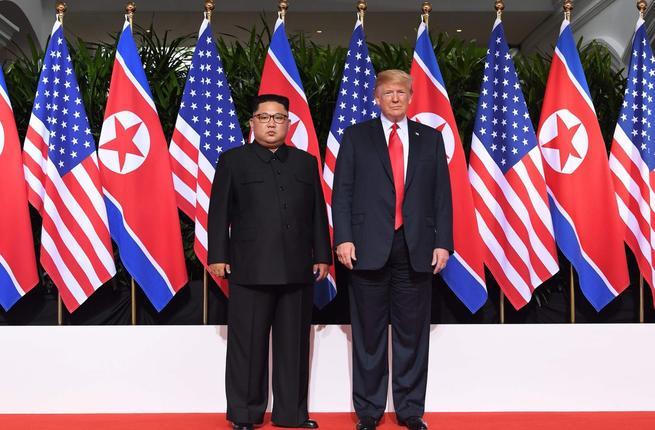 |
|
North Korean leader Kim Jong-un and US President Donald Trump pose for a commemorative photograph during their Singapore summit on June 12.
|
Location likely to be least controversial point
After White House Press Secretary Sarah Huckabee Sanders said on Sept. 10 that the US was “coordinating” the schedule of a second North Korea-US summit, there’s growing interest about what agreement will be reached on the three major conditions for holding a summit, namely the location, time and agenda. The point that’s likely to be the least controversial is the location. After US President Donald Trump held his historic summit with North Korean leader Kim Jong-un on June 12, he expressed his desire to hold their second summit at the White House. When Trump was asked by reporters after he and Kim signed the June 12 joint statement whether he would invite Kim to the White House, Trump said, “Absolutely, I will.” Given the historic significance of the first summit – the first time that the leaders of North Korea and the US had met face to face during their 70-year conflict – Pyongyang and Panmunjom were among the major contenders to host the summit, but the ultimate choice was Singapore, a neutral location for both sides. While Trump could suddenly decide to head to Pyongyang, that shouldn’t be seen as likely given the resistance from the American mainstream to excessive contact between North Korea and the US. When asked about the location of the second summit, Sanders would only say, “We’ll let you know when we have further details.” Additional questions concerning date and agenda The second and third questions – the summit’s date and agenda – are closely linked. While Trump has repeatedly mentioned the possibility of holding a second summit, he has dodged making specific comments about the timing with remarks such as, “We’ll see what happens.” But some major hints can be gleaned from the political calendar in the US in the second half of the year. Trump finds himself needing to showcase his major accomplishments over the past two years in order to achieve victory in the midterm elections this November. One topic that gets brought up frequently is his diplomatic success with North Korea. During a number of recent campaign rallies and press conferences, Trump has said that his major accomplishments include building rapport with Kim, North Korea’s repatriation of the remains of American service members killed during the Korean War, and North Korea’s refraining from committing any nuclear weapon or missile provocations so far this year. Trump needs to make headway with North Korea for midterm elections But during the second summit, Trump needs to make concrete progress on the promises and declarations made during the first summit about resetting North Korea-US relations, creating a permanent and firm peace regime on the Korean Peninsula and achieving the peninsula’s complete denuclearization. Ultimately, the agenda is the key variable that will determine whether the summit is held and, if so, whether it’s successful. Sanders said that one of the main reasons Trump accepted the proposal for a second summit was the “very warm, very positive letter” he received from Kim. “The primary purpose of the letter was to request and look to schedule another meeting” – that is, a second summit – “with the President,” Sanders said. According to Sanders, Kim’s letter also “showed a commitment to continuing conversations, continuing to work on the progress [. . .] since their meeting [. . .] and also, a continued commitment to focus on denuclearization of the Peninsula.” The current North Korea-US negotiations have gotten bogged down in a tedious dispute over the sequence and method of North Korea’s disclosure of its nuclear facilities and the formal declaration of the end of the Korean War. While North Korea has prioritized the end-of-war declaration as a way of securing trust between the two sides, the US has countered by saying that the disclosure of nuclear facilities – the first and most important step in denuclearization – needs to come first. Second summit could be held in October before midterm elections If progress definite enough to break through the current deadlock is made during the major upcoming diplomatic events, including the third inter-Korean summit on Sept. 18-20 and the South Korea-US summit in New York at the end of September, as well as the concurrent deliberations between North Korea and the US, Trump might ultimately hold a second summit in October, before the midterm elections in November. Singapore wasn’t finalized as the site of the first summit until May 25, following a fracas in which the whole summit was nearly called off. At the time, low-level officials from North Korea and the US managed to complete the technical preparations for the summit in just 19 days and pulled off the summit on June 12. But if the deadlock drags on, Trump will have no reason to rush a meeting while taking on additional political risk. In that event, he’s likely to keep emphasizing his commitment to dialogue and his diplomatic achievements vis-à-vis North Korea until the midterm elections are over while taking time to weigh the date of the schedule. By Gil Yun-hyung, staff reporter Please direct comments or questions to [english@hani.co.kr]






